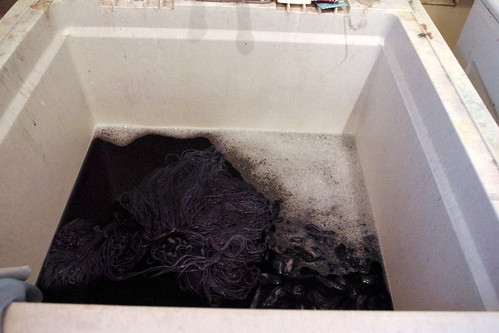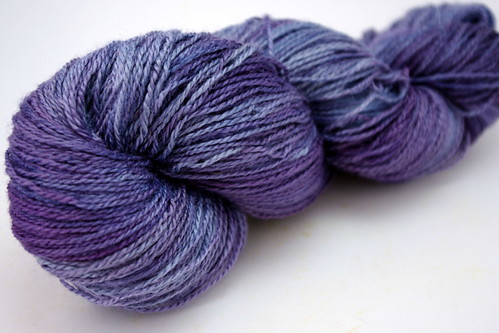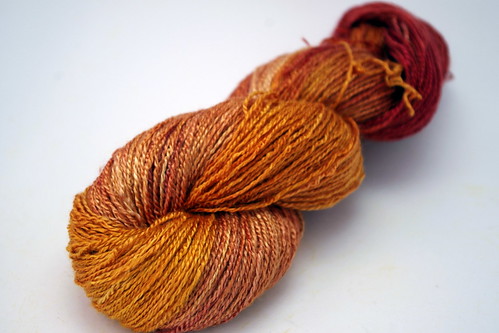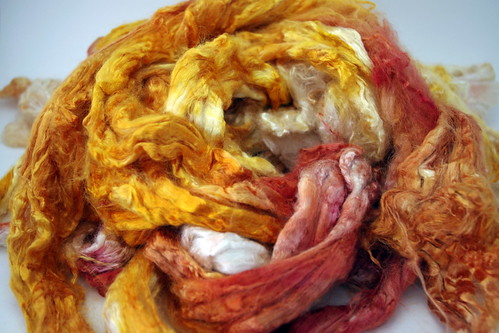Over the last year or so, I've gotten several requests to carry plant-based yarns (occasionally people do note that with a business name of "Waterloo Wools" they can understand why this isn't my focus, but usually go on to add "but it would be great if..."). The reasons for this vary, although a common one is allergies to wool or other animal fibres, and I do hate that there are people whose skin doesn't allow them to wear/work with my yarns. :(
Another common reason given is environmental, especially as people often hear about bamboo being a great renewable resource. However, some of you may have noticed that my wool/plant fibre blends are typically labelled as containing "bamboo rayon" or "bamboo viscose." This because the soft, shiny, drapey bamboo fibres many of us have come to love have been processed into a rayon. This process makes them soft & silky & desirable, but it's not an environmentally neutral process, and it negates a lot of the "green" effect of starting with a renewable resource.
However, despite this factor I was still interested in offering some plant-based yarns & fibres to my customers, so I've been checking the options with my suppliers. There aren't a huge number of options offered by the major suppliers I work with, but I bought an assortment of what they did have. I also bought a small set of fibre reactive dyes, which are the dyes required for most plant fibres. And finally, last week, I decided to take the plunge and try it all out.
The dyeing process itself is slightly more complex than the standard process I use with acid dyes, but not dramatically difficult. I measured all the ingredients carefully, erring on the side of less dye because I had read about how difficult it can be to rinse all the excess dye out of plant fibres. I also let the dyes "marinate" much longer than required for this reason. And despite these efforts, I found that every warning about how much rinsing is required was spot on!

This was the scene in my sink on what I think was the 4th rinse of this batch. Notice how the water isn't really anywhere close to running clear? And this batch was the one that rinsed faster--I think it was only 2 more rinses after the one pictured. The other batch seemed to take at least 8, maybe 10. So to me, this is another big strike against bamboo in the environmentally friendly category--dyeing it requires significantly more water than dyeing wool, and results in a lot more dye being rinsed away. The information I have is that it's not harmful to rinse the excess dye down the drain into the municipal water system, but I can't imagine it's a great thing to do in large quantities either!
The end results? Well, they're not all bad:

That's some cotton fibre that I picked up at the K-W Knitters' Fair several years ago, before I even knew that I needed different dyes to dye plant fibres. So it's languished in my stash because spinning white cotton didn't sound like much fun! Interestingly, it was VERY hard to get water to penetrate to the middle of the fibre, resulting in all those white streaks after dyeing. I'm looking forward to spinning this, but it's not something that my suppliers carry so I don't expect to get any more.

This is soy yarn. The interesting thing about soy is that although it is a plant fibre, it is also a protein fibre, meaning it can react with both types of dye. So I would consider carrying this base yarn, and dyeing it with my ordinary acid dyes--which I find actually give it a more vibrant colour anyway. It has the same sort of drape & sheen as a bamboo yarn. Right now my supplier doesn't offer it in a lot of different yarn weights, but I'm thinking of stocking this one (fingering) for now, and potentially expanding depending on interest.

This is the bamboo yarn. It turned out fine, but there's nothing remarkable about it and it certainly doesn't seem worth the effort. I think I have one more skein of it to play with, so I'll go ahead and dye that, but then I won't be buying any more of it.

Bamboo fibre. Note the rather messy state of it! That probably could have been partly controlled if I had thought about it in advance, because I know that bamboo fibres separate when they hit the water. I have some methods in mind for containment in the future which would probably result in a slightly neater fibre, but it will always be messier than a wool fibre. Fortunately, my main plans for this were to blend it with other fibres into a batt, so it will work fine for that! I do have a few more bumps of bamboo, so I will be dyeing several other colours to use up what I have--but again, I don't anticipate ordering more after that.
In conclusion...the only plant based yarns & fibres I will consider regularly stocking are ones that can be dyed with acid dyes, like soy. The only other fibre I can think of that is in a similar category is milk fibre--obviously not actually PLANT based, but not a wool/hair based fibre either, so it should be suitable for those with wool allergies. Right now I'm carrying a blend that is mostly milk, because my supplier doesn't do a 100% milk yarn--but if they add one, I'll consider that, too. Otherwise, I'll use up the dyes & fibres I have and head back to the familiar world of wool!
Another common reason given is environmental, especially as people often hear about bamboo being a great renewable resource. However, some of you may have noticed that my wool/plant fibre blends are typically labelled as containing "bamboo rayon" or "bamboo viscose." This because the soft, shiny, drapey bamboo fibres many of us have come to love have been processed into a rayon. This process makes them soft & silky & desirable, but it's not an environmentally neutral process, and it negates a lot of the "green" effect of starting with a renewable resource.
However, despite this factor I was still interested in offering some plant-based yarns & fibres to my customers, so I've been checking the options with my suppliers. There aren't a huge number of options offered by the major suppliers I work with, but I bought an assortment of what they did have. I also bought a small set of fibre reactive dyes, which are the dyes required for most plant fibres. And finally, last week, I decided to take the plunge and try it all out.
The dyeing process itself is slightly more complex than the standard process I use with acid dyes, but not dramatically difficult. I measured all the ingredients carefully, erring on the side of less dye because I had read about how difficult it can be to rinse all the excess dye out of plant fibres. I also let the dyes "marinate" much longer than required for this reason. And despite these efforts, I found that every warning about how much rinsing is required was spot on!

This was the scene in my sink on what I think was the 4th rinse of this batch. Notice how the water isn't really anywhere close to running clear? And this batch was the one that rinsed faster--I think it was only 2 more rinses after the one pictured. The other batch seemed to take at least 8, maybe 10. So to me, this is another big strike against bamboo in the environmentally friendly category--dyeing it requires significantly more water than dyeing wool, and results in a lot more dye being rinsed away. The information I have is that it's not harmful to rinse the excess dye down the drain into the municipal water system, but I can't imagine it's a great thing to do in large quantities either!
The end results? Well, they're not all bad:

That's some cotton fibre that I picked up at the K-W Knitters' Fair several years ago, before I even knew that I needed different dyes to dye plant fibres. So it's languished in my stash because spinning white cotton didn't sound like much fun! Interestingly, it was VERY hard to get water to penetrate to the middle of the fibre, resulting in all those white streaks after dyeing. I'm looking forward to spinning this, but it's not something that my suppliers carry so I don't expect to get any more.

This is soy yarn. The interesting thing about soy is that although it is a plant fibre, it is also a protein fibre, meaning it can react with both types of dye. So I would consider carrying this base yarn, and dyeing it with my ordinary acid dyes--which I find actually give it a more vibrant colour anyway. It has the same sort of drape & sheen as a bamboo yarn. Right now my supplier doesn't offer it in a lot of different yarn weights, but I'm thinking of stocking this one (fingering) for now, and potentially expanding depending on interest.

This is the bamboo yarn. It turned out fine, but there's nothing remarkable about it and it certainly doesn't seem worth the effort. I think I have one more skein of it to play with, so I'll go ahead and dye that, but then I won't be buying any more of it.

Bamboo fibre. Note the rather messy state of it! That probably could have been partly controlled if I had thought about it in advance, because I know that bamboo fibres separate when they hit the water. I have some methods in mind for containment in the future which would probably result in a slightly neater fibre, but it will always be messier than a wool fibre. Fortunately, my main plans for this were to blend it with other fibres into a batt, so it will work fine for that! I do have a few more bumps of bamboo, so I will be dyeing several other colours to use up what I have--but again, I don't anticipate ordering more after that.
In conclusion...the only plant based yarns & fibres I will consider regularly stocking are ones that can be dyed with acid dyes, like soy. The only other fibre I can think of that is in a similar category is milk fibre--obviously not actually PLANT based, but not a wool/hair based fibre either, so it should be suitable for those with wool allergies. Right now I'm carrying a blend that is mostly milk, because my supplier doesn't do a 100% milk yarn--but if they add one, I'll consider that, too. Otherwise, I'll use up the dyes & fibres I have and head back to the familiar world of wool!
Comments